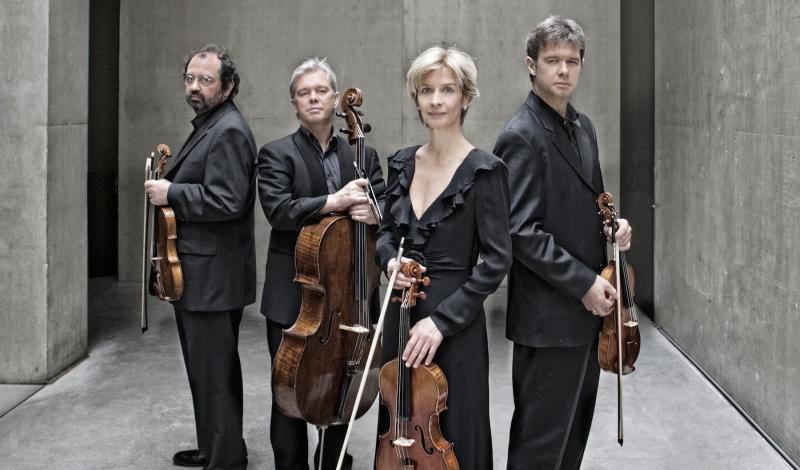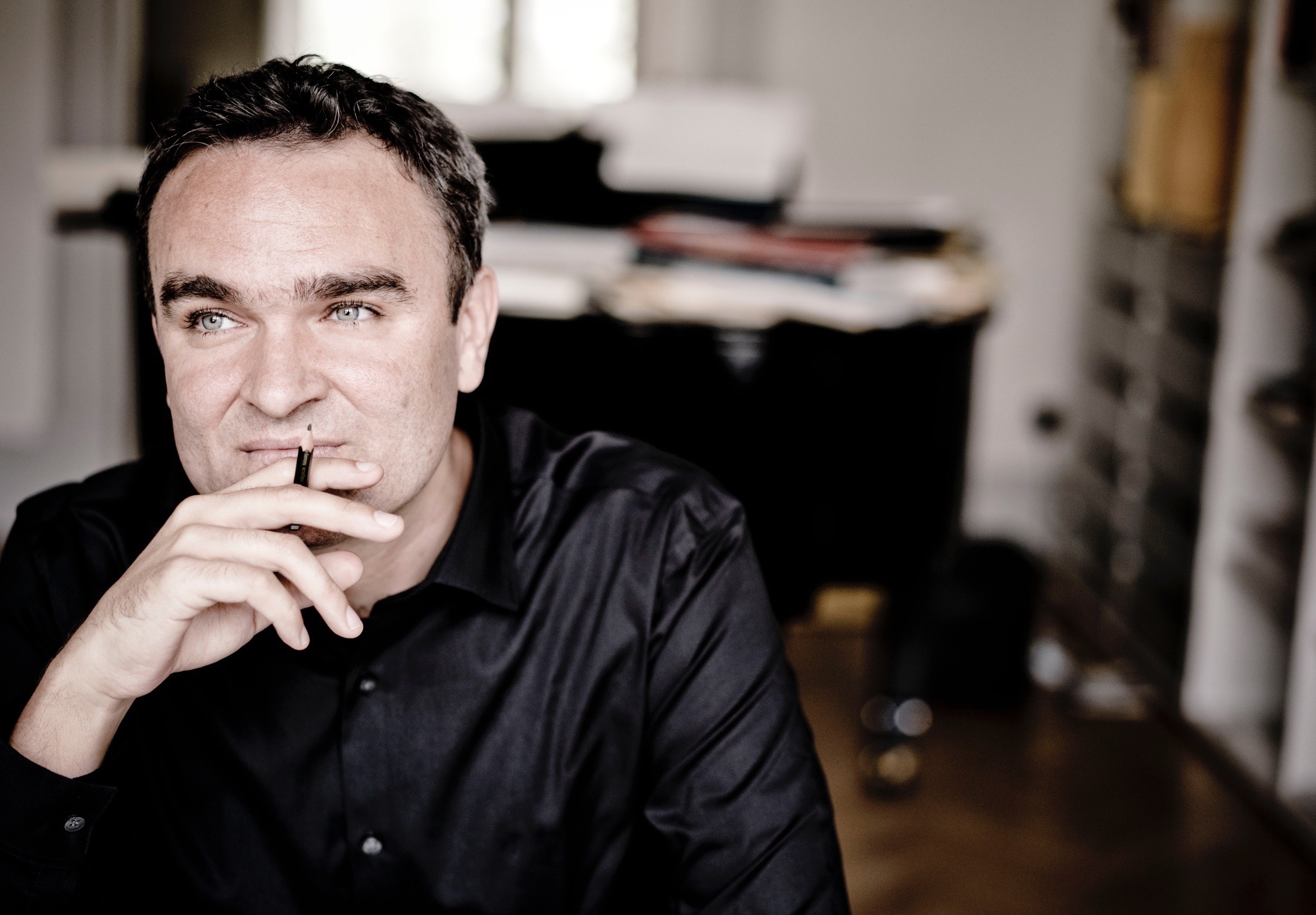Hagen Quartet, Jörg Widmann, Wigmore Hall review – proportion and elegance | reviews, news & interviews
Hagen Quartet, Jörg Widmann, Wigmore Hall review – proportion and elegance
Hagen Quartet, Jörg Widmann, Wigmore Hall review – proportion and elegance
Widmann’s new quintet a study in reserve and intimacy

Jörg Widmann writes fast. He is also one of the few young German composers who can write distinctive and idiomatic music without feeling the weight of his country’s musical heritage on his shoulders at every turn. Surprisingly, then, his Clarinet Quintet, which here received its UK premiere at Wigmore Hall, was eight years in the making, and was initially abandoned because "music history ...
Widmann (pictured below by Marco Borggreve) credits that change of heart to the Hagen Quartet, with whom he played this evening, and they are certainly a good match. His music is often quiet, relying on muted harmonies and soft but richly shaded sonorities – the very qualities that make the Hagen sound special. There is plenty more here, too, from extended bowing techniques to clarinet multiphonics, but the Hagens took it all in their stride.
The work is a 40-minute Lento, and there is a feeling throughout of suppressed Romantic expression, as if the music continually wants to shift up a gear or launch into a searing climax. The climaxes, when they do come, are either frustrated by the slow tempo or interrupted before they begin. And the rest of the music hovers around silence, relying on the clarinet’s ability to play at the edge of audibility. At one point, the pitches disappear altogether, and Widmann simply blows air through his clarinet while the strings bow the bodies of their instruments. From there, the music gradually returns, but always seems on the verge of disappearing again at any minute.
On top of all this, Widmann adds a big, Romantic melody. The disjunction between avant-garde and romantic would jar in lesser hands, but Widmann gets the balance just right. The melody always appears over ambiguous harmonies, or even unpitched sounds, and is only ever present for an instant before melting back into the textures. There’s no apparent irony here, nor any knowing reference back to the Romantic era – he plays it straight, and somehow gets away with it, even if he’s right on the edge of good taste. As if to emphasise that Widmann does indeed speak from within the Austro-German tradition, the Hagen Quartet prefaced his work with the Webern String Quartet of 1905. Like the Widmann, this plays out as a single slow span (though it is actually three movements run together), melodically rich, but always supported by dark, nebulous harmonies. This, too, is perfect music for the Hagen Quartet, who infuse every minute gesture with meaning and expression through the elegance of their dark, burnished tone.
As if to emphasise that Widmann does indeed speak from within the Austro-German tradition, the Hagen Quartet prefaced his work with the Webern String Quartet of 1905. Like the Widmann, this plays out as a single slow span (though it is actually three movements run together), melodically rich, but always supported by dark, nebulous harmonies. This, too, is perfect music for the Hagen Quartet, who infuse every minute gesture with meaning and expression through the elegance of their dark, burnished tone.
Mozart, however, calls for a brighter sound, and for his Clarinet Quintet in the second half, Widmann and the Hagens moved towards a more straightforward, classical tone. Even so, the playing was still reserved, with generally steady tempos and quiet dynamics, which served to highlight the intimacy and playfulness of this music. Widmann performed very much as part of the ensemble, with little ostentation, no vibrato, and modest, if sometimes quirky ornaments. Mozart’s writing for the string ensemble here is unusually democratic, with many exposed moments for the viola and cello, with whom Widmann would closely interact – lots of eye contact from him, and rarely a glance at the music. There were a few surprising moments, like the last slow episode of the finale, before the coda, which was brought to almost to a standstill while the players luxuriated in the open, airy textures. But on the whole, this was a measured and disciplined reading. Some may have found it overly mannered or lacking in expression, but to me it was the very model of classical proportion and elegance.
rating
Explore topics
Share this article
The future of Arts Journalism
You can stop theartsdesk.com closing!
We urgently need financing to survive. Our fundraising drive has thus far raised £49,000 but we need to reach £100,000 or we will be forced to close. Please contribute here: https://gofund.me/c3f6033d
And if you can forward this information to anyone who might assist, we’d be grateful.

Subscribe to theartsdesk.com
Thank you for continuing to read our work on theartsdesk.com. For unlimited access to every article in its entirety, including our archive of more than 15,000 pieces, we're asking for £5 per month or £40 per year. We feel it's a very good deal, and hope you do too.
To take a subscription now simply click here.
And if you're looking for that extra gift for a friend or family member, why not treat them to a theartsdesk.com gift subscription?
more Classical music
 Kempf, Brno Philharmonic, Davies, Bridgewater Hall, Manchester review - European tradition meets American jazz
Bouncing Czechs enjoy their Gershwin and Brubeck alongside Janáček and Dvořák
Kempf, Brno Philharmonic, Davies, Bridgewater Hall, Manchester review - European tradition meets American jazz
Bouncing Czechs enjoy their Gershwin and Brubeck alongside Janáček and Dvořák
 Solomon, OAE, Butt, QEH review - daft Biblical whitewashing with great choruses
Even a top soprano and mezzo can’t make this Handel paean wholly convincing
Solomon, OAE, Butt, QEH review - daft Biblical whitewashing with great choruses
Even a top soprano and mezzo can’t make this Handel paean wholly convincing
 Two-Piano Gala, Kings Place review - shining constellations
London Piano Festival curators and illustrious friends entertain and enlighten
Two-Piano Gala, Kings Place review - shining constellations
London Piano Festival curators and illustrious friends entertain and enlighten
 Echo Vocal Ensemble, Latto, Union Chapel review - eclectic choral programme garlanded with dance
Beautiful singing at the heart of an imaginative and stylistically varied concert
Echo Vocal Ensemble, Latto, Union Chapel review - eclectic choral programme garlanded with dance
Beautiful singing at the heart of an imaginative and stylistically varied concert
 Scott, Irish Baroque Orchestra, Whelan, RIAM, Dublin review - towards a Mozart masterpiece
Characteristic joy and enlightenment from this team, but a valveless horn brings problems
Scott, Irish Baroque Orchestra, Whelan, RIAM, Dublin review - towards a Mozart masterpiece
Characteristic joy and enlightenment from this team, but a valveless horn brings problems
 Classical CDs: Voice flutes, flugelhorns and froth
Baroque sonatas, English orchestral music and an emotionally-charged vocal recital
Classical CDs: Voice flutes, flugelhorns and froth
Baroque sonatas, English orchestral music and an emotionally-charged vocal recital
 Kanneh-Mason, Britten Sinfonia, Shave, Milton Court - a grin and a big beaming smile
A pair of striking contemporary pieces alongside two old favourites
Kanneh-Mason, Britten Sinfonia, Shave, Milton Court - a grin and a big beaming smile
A pair of striking contemporary pieces alongside two old favourites
 theartsdesk at the New Ross Piano Festival - Finghin Collins’ musical rainbow
From revelatory Bach played with astounding maturity by a 22 year old to four-hand jazz
theartsdesk at the New Ross Piano Festival - Finghin Collins’ musical rainbow
From revelatory Bach played with astounding maturity by a 22 year old to four-hand jazz
 First Person: Manchester Camerata's Head of Artistic Planning Clara Marshall Cawley on questioning the status quo
Five days of free events with all sorts of audiences around Manchester starts tomorrow
First Person: Manchester Camerata's Head of Artistic Planning Clara Marshall Cawley on questioning the status quo
Five days of free events with all sorts of audiences around Manchester starts tomorrow
 Goldscheider, Brother Tree Sound, Kings Place review - music of hope from a young composer
Unusual combination of horn, strings and electronics makes for some intriguing listening
Goldscheider, Brother Tree Sound, Kings Place review - music of hope from a young composer
Unusual combination of horn, strings and electronics makes for some intriguing listening

Add comment